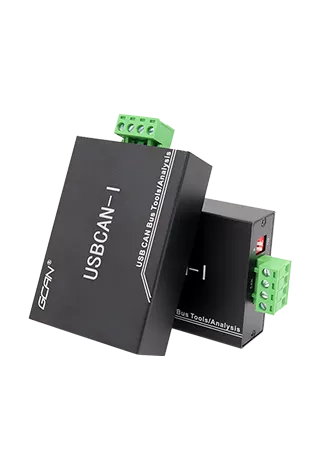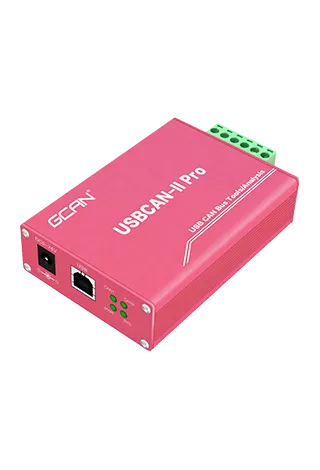Les novices peuvent rencontrer des problèmes courants lorsqu'ils utilisent USB vers CAN. Voici un résumé clair de quelques problèmes courants et de leurs solutions :
1. Problème d'installation du pilote
Description du problème :
Le pilote de l'analyseur CAN n'est pas installé correctement, ce qui empêche l'appareil de communiquer normalement avec l'ordinateur.
Solution :
Vérifiez si le fichier du pilote correspond aux différentes séries d'interfaces et aux différents systèmes d'exploitation.
Installer selon le fichier de pilote correct fourni par l'entreprise.
2. Problème de connexion à l'interface USB
Description du problème :
La connexion à l'interface USB est instable, ce qui entraîne une interruption ou une instabilité de la transmission des données.
Solution :
Rebranchez le port USB.
Vérifiez que le voyant d'état USB est allumé pour vous assurer que la connexion est stable.


3. Mauvaise sélection du modèle d'appareil
Description du problème :
Le mauvais modèle d'analyseur CAN a été sélectionné lors de l'ouverture de la liste des appareils, ce qui a empêché le logiciel d'identifier correctement l'appareil.
Solution :
Sélectionnez le modèle correspondant dans la liste des appareils en fonction du modèle de produit spécifique.
4. Le logiciel n'a pas réussi à ouvrir le dispositif
Description du problème :
Le logiciel ne peut pas ouvrir l'appareil ou ne peut pas l'identifier.
Solution :
Confirmez que le pilote a été installé correctement.
Vérifier si la sélection du modèle d'appareil est correcte.
Vérifiez si le port CAN est occupé par d'autres programmes. Si c'est le cas, fermez les autres programmes.
5. Problème de réception des données
Description du problème :
L'appareil est allumé mais le logiciel de l'ordinateur hôte ne contient pas de données.
Solution :
Vérifier si le débit en bauds sélectionné lors de la mise sous tension de l'appareil est correct.
Vérifier si la résistance terminale est activée (en cas de communication à vitesse de transmission élevée).
Vérifiez si le câblage est correct. La ligne CAN est constituée de deux fils, H et L, qui doivent être connectés correctement.
6. Échec de l'ouverture du port série
Description du problème :
Échec lors de l'ouverture du port série.
Solution :
Vérifiez que l'appareil est correctement inséré dans l'interface USB de l'ordinateur.
Réinstallez le pilote.
Vérifiez si d'autres programmes utilisent actuellement le port série et fermez les programmes concernés.
Vérifiez si l'utilisateur actuel a le droit d'accéder au périphérique du port série. Si ce n'est pas le cas, rejoignez le groupe d'utilisateurs de l'accès au port série ou exécutez le programme correspondant en tant qu'administrateur.
Vérifiez que le débit en bauds de l'interface entre l'appareil et l'ordinateur est cohérent et effectuez les réglages correspondants.


7. Vitesse de transmission des données lente
Description du problème :
Le module USB-CAN envoie et reçoit des données lentement.
Raisons possibles :
Problèmes matériels, tels que des problèmes de qualité de l'équipement, des modules émetteurs-récepteurs CAN endommagés, des composants sur la carte de circuit imprimé, etc.
Problèmes de logiciel, tels que l'installation d'un pilote incorrect ou d'une version obsolète, une erreur de configuration du logiciel, etc.
Problèmes environnementaux, tels que les interférences électromagnétiques, les problèmes d'alimentation électrique, etc.
Problèmes d'utilisation, tels qu'un placement aléatoire de l'appareil, une méthode de connexion incorrecte, etc.
Solution :
Vérifiez et mettez à jour le pilote du module USB vers CAN avec la dernière version.
Reconfigurez les paramètres du module USB vers CAN pour vous assurer que tous les paramètres sont réglés correctement.
Vérifier l'environnement de travail de l'appareil pour s'assurer qu'il n'y a pas d'interférences électromagnétiques et que l'alimentation électrique est stable.
Faites attention à la méthode d'utilisation et de stockage de l'appareil afin d'éviter les collisions et les chutes.
Si vous avez besoin d'un analyseur USB à CAN, n'hésitez pas à nous contacter. 008613644001762/info@gcanbus.com
